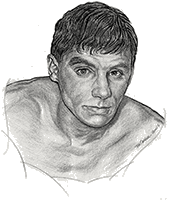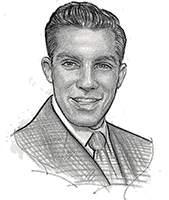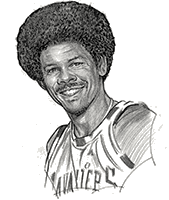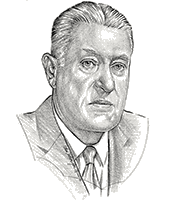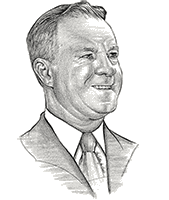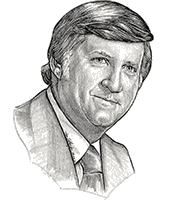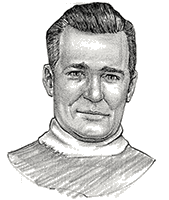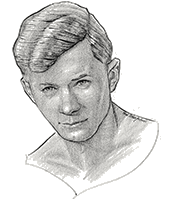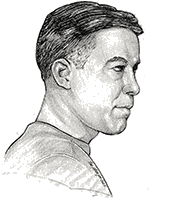Robert Smith was the best football player ever at Euclid High School—a two-time Mr. Ohio Football, Ohio’s Division 1 Back-of-the-Year in 1988 and 1989, gaining 5, 318 yards on 563 carries and scoring 71 touchdowns in three brilliant seasons. He led the Panthers to a 29-5 record, three Greater Cleveland Conference titles, and three trips to the state playoffs. As a result he was named not only a High School All-American as a senior, but the 1989 Gatorade Circle of Champions National High School Football Player of the Year and was also honored by the Washington TD Club as the Dial Soap High School Player of the Year. Taking his talents next to Ohio State, he shattered the revered Archie Griffin’s freshman rushing record, running for 1,126 yards in his first year. After leading the Buckeyes in rushing as a junior in 1992, he entered the NFL draft, where he became the first round (21st overall) pick of the Minnesota Vikings in 1993. Despite a series of injuries, he won recognition as one of the NFL’s best running backs over the ensuing eight seasons, rushing for a club record 6,818 yards and being named to the 1998 and 2000 Pro Bowls. His best season came in 2000 when he rushed for 1,521 yards to lead the NFC. It was the only season in which he was able to play in all 16 games of the campaign. But after undergoing his third knee surgery, he elected to retire from football at the age of 28. Now the co-owner of a software company with another Cleveland football standout Tom Cousineau, and owner of a construction company, he currently makes his home in Pembroke Pines, Florida.
At age 17, Tommy Salem had an athletic scholarship to Michigan State and a scholarship to the Cleveland Institute of Art in his pocket and was well along the path in his studies to become a concert violinist. The choice was obvious to the youngster from Bolivar Rd. in downtown Cleveland. With an amazing 126 bouts already under his belt as an amateur in the flyweight, bantamweight and featherweight divisions, he elected to become a professional boxer. By the time he turned 18 he was fighting some of the world’s best featherweights and had been featured as the world’s “Featherweight of the Month” by the National Boxing Association. Boxing in elimination bouts to become the next contender to face Sandy Saddler for the featherweight title, he ended Auburn Copeland’s undefeated string of 26 wins, to set up a match with Charley Riley, ranked No.3 in the world. Now 19, he lost a split decision, which prevented him from moving up in the rankings behind Saddler and Willie Pep. A draft call for the Korean War put his career on hold from 1951-53, after which he resumed competing in elimination bouts as a lightweight until he retired in 1958, with a record of 40 wins, including 11 knockouts, and eight losses. Two of those losses were disputed split decisions in New York City to highly rated Johnny Busso and future lightweight champion Carlos Ortiz. Ortiz was later quoted as saying his fight with the Cleveland contender was the toughest of his career. After putting away his gloves he attended college and pursued a career in advertising and sales. He and his wife Dorothy, a college professor, make their home in Independence.
Deceased 2015
Even in the 1940s when 6′ 5″ high school basketball players were considered giants, Marlo Termini was still classified as a “mighty mite.” Thus it was understandable why the 5′ 2″ Holy Name High School junior guard captured the imagination of Cleveland sports fans when he led his team to its first-ever city cage championship with a 39-32 victory over Collinwood at Public Hall in 1944. The tiny co-captain was both the team’s brainy floor general and scoring leader at 11.4 ppg. and was named to the All-Senate team. He seemed to be on track for a spectacular senior season, but there was a war on, and he spent the 1945 season in the army instead. After his release, he enrolled at the University of Dayton and became an immensely popular player in the Flyers’ strong cage program before he left to join a Detroit semi-pro team. Later he turned his considerable talents to fast-pitch softball, at a time when Cleveland was a hotbed of the sport. He starred for several championship clubs and, as a center fielder and speedy lead-off hitter, earned a reputation as one of the best ever to play the game here. In a 14-year career he never played on a losing club and was a key player on the 1957 General Teamsters team that became the first squad to represent the city in the national championships in 30 years.
Deceased 2018
One of the original Cleveland Cavaliers, Bingo Smith was picked in the 1970 expansion draft from the San Diego Rockets, who had made him a first round choice in the previous year’s college draft. The ex-Tulsa University All-American became an instant hit in Cleveland with his patented rainbow jumper often fired from the farthest reaches of an arena. Then, on his historic night in April, 1976 at the Richfield Coliseum, one of those long distance bombs was to become one of the most famous shots in Cavaliers history: a last-second three-pointer that earned the team its first-ever post-season playoff game victory. Immediately, it was immortalized as “The Miracle of Richfield.” There were many other points scored by Smith as well: 9,513 in regular season games (fourth best total in Cleveland history) and 198 in post season play. In his nine-plus seasons with the Cavs, Bingo did more than enough to merit retiring his No.7 jersey and his recent selection as one of the team’s top 12 players of all time. Traded back to San Diego in the 1979-80 season, he retired after that campaign and returned to Cleveland where he has devoted much of his time to working with youth groups in the Northeastern Ohio area.
Deceased 2023
Owner of the Cleveland professional hockey club, known chronologically as the Indians, Falcons and Barons during his ownership from 1930 until 1949. He built the Cleveland Arena in 1937, a building which remained a show place for indoor sports in Cleveland for more than 35 years. Interested and actively involved in many other sports, he served as chairman of the Boxing Commission in the early ’30s.
Active on the Cleveland sports scene for 41 years, eh served as athletic director at Cleveland James Ford Rhodes High School from 1933 to 1942 and subsequently as Director of Playgrounds and Community Centers for the Cleveland Board of Education. He was president of the Greater Cleveland Boxing Commission in 1953, National AAU Chairman for Olympic Development in 1964 and president of the Lake Erie AAU. He helped launch the Junior Olympics program in 1946.
A devoted friend of handicapped and underprivileged youngsters and of sports and athletes on both amateur and the professional level, he owned the Cleveland Pipers basketball team, an early entry (1950s) in professional basketball here and headed Group 66, an organization devoted to promoting civic improvement, including the support of athletic programs, in Cleveland. Became principal owner of the New York Yankees in 1973.
Member of Canadian Hockey Hall of Fame. Scored over 100 goals for Cleveland Blues between 1919 and 1924. When the team disbanded he joined the old Montreal Maroons of the National Hockey League and became the first NHL player to score over 300 goals in a career. Also played with Boston and closed career with the New York Americans at close to age 40 with 324 NHL goals.
Won National AAU championship at 135 pounds in 1914, representing The Cleveland Athletic Club. One of four Cleveland boxers to win titles that year. Their showing launched a highly successful era of amateur boxing in Cleveland.
One of best bantamweight fighters of the 1920s, although never given the opportunity to fight for the title. His 12-round, no-decision fight with Bantamweight Champion Eddie “Cannibal” Martin at Cleveland Public Hall in 1925 has been hailed as one of the greatest fights ever staged in Cleveland. Late in his career he scored a notable victory knocking out youthful Benny Gershe.
2001 Crocker Rd., Ste. 510, Westlake, OH 44145
Phone: 216-241-1919


